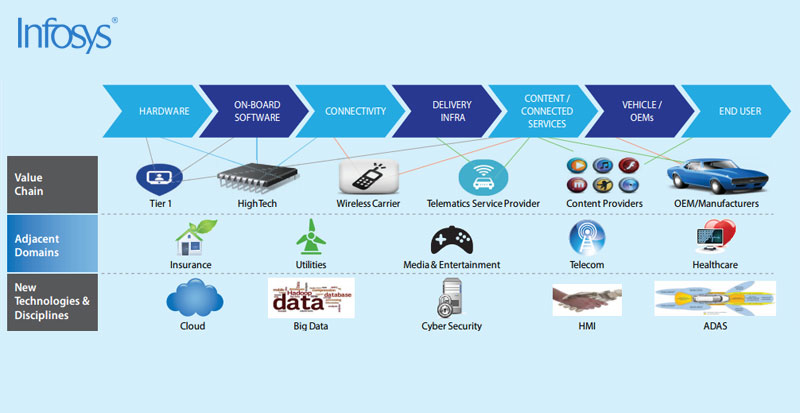Smart manufacturing, also known as Industry 4.0, promises to revolutionise the automotive industry, and Europe is leading the way. Infosys, an Indian-based specialist in business consulting, software engineering, information technology and outsourcing services, expects that almost €150bn (US$165bn) will be spent in this area in Europe alone over the coming five years. “Almost all of the customers to which we are talking have started initiatives in this direction,” Ruchir Budhwar, Regional Head Designate – Manufacturing (Europe) at Infosys, told Megatrends.
Digitally connecting everything
Budhwar believes that smart manufacturing is dramatically changing the traditional focus areas for manufacturing companies – namely productivity optimisation, cost reduction and quality improvement. “Smart manufacturing is being seen as an enabler of delivering innovative new products and services,” he added.
Smart manufacturing is all about digitally connecting everything inside and outside the manufacturing industry. As Budhwar elaborated: “When it is inside, we are talking about horizontal integration, digitally connecting various aspects like the supply chain and consumers.” This involves sensors and devices communicating with each other, providing information directly from the supply chain to the shop floor.
The vertical aspect refers to integrating a company’s business information management systems. “There is a lot of real time analysis happening at a corporate level to get real time operations and metrics around those operations,” said Budhwar. “We are seeing a lot of activity happening on the horizontal side as well as on the vertical side.”

Benefits and risks
The adoption rate has been slow but steady, with Europe in the vanguard. As for the benefits this approach can bring, it all depends on the use case. One of the most common applications is in the area of preventive maintenance. “Whether it is a chemical plant or an automotive plant or any other manufacturing operation, the most important aspect from a productivity, cost and quality standpoint is that the plant be up and running to manufacture the goods and services,” he said. “By putting in sensors and gathering information, this is used to prevent failures at plants. Earlier we used to talk about mean time to repair and mean time to recovery, and now we are talking about preventing any failures at plants.”
Most notably, these sensors can gather “tons of information,” added Budhwar, and Big Data use cases are being applied. With it, however, come security concerns. “Security is a big topic in smart manufacturing,” he commented. “With so much data available and flowing around, how do you secure it so that it is not hacked into or mismanaged? That is a bigger question.”
Standards no hindrance
Standards, or a lack of them, can make or break the rise of any new technology. As more vehicle manufacturers show an interest in smart manufacturing, are new guidelines required? “Most of today’s integration and high productivity levels have been because of standards that have evolved over the last two decades,” explained Budhwar. “Before that, particularly in industrial automation, they have had numerous challenges on proprietary technologies where we struggled. But new devices and optimisation and communication mechanisms, together with the Internet of Things (IoT), have enabled the applications and strategies to evolve.”
While Budhwar isn’t saying that the necessary standards are all here today, he emphasises that “significant progress has been made and we are reaching a situation where standards would not be a hindrance to this kind of transformation.”

Shift to high-tech industry
One of the key industry forces behind smart manufacturing is the convergence with the high-tech industry. “The manufacturing industry is moving closer towards the high-tech industry. Historically, it’s been all about assembly lines and machines and putting together a beautiful product. But today the whole thing – the move towards autonomous cars, electric cars – has to be enabled by more and more IT,” said Budhwar. “The more you move from manufacturing to high-tech, the closer you get to IT. Software is going to become the core of the car going forward.”
Successfully adapting to this movement requires a huge amount of change from companies like Infosys, demanding greater attention to innovation. “We are increasingly focusing on IT in the car and innovation inside the car. That’s the disruption that is happening in the automotive industry,” he said. “Customers are expecting a huge amount of automation from us in terms of the way we provide those services. And reducing waste in IT services and automation are all things which are aligned with lean production or lean production techniques. As a service provider, the way we operate has to change. We have to focus more on automation and that’s what we are doing.”
A learning-based culture
As technology advances at an increasingly rapid pace, how can companies like Infosys ensure access to a workforce with the right skills? Budhwar believes that the key for any company in this environment is to adopt a learning-based culture.
“Technology has been changing and will continue to change. The topics of discussion today have changed from what they were yesterday and will change in the future,” he observed. “We used to talk about technology like the Internet a few years back. It evolved into responsive web design and we are now talking about Big Data. What is important is that we are a learning organisation.”
Infosys has been investing heavily in internal training facilities, and offers one of the largest corporate universities in the world, located in Mysore. “That training is evolving,” he pointed out. “Learning plays a big role, and any shortage of technology skills has to be overcome by building a learning-based culture in the organisation.”



